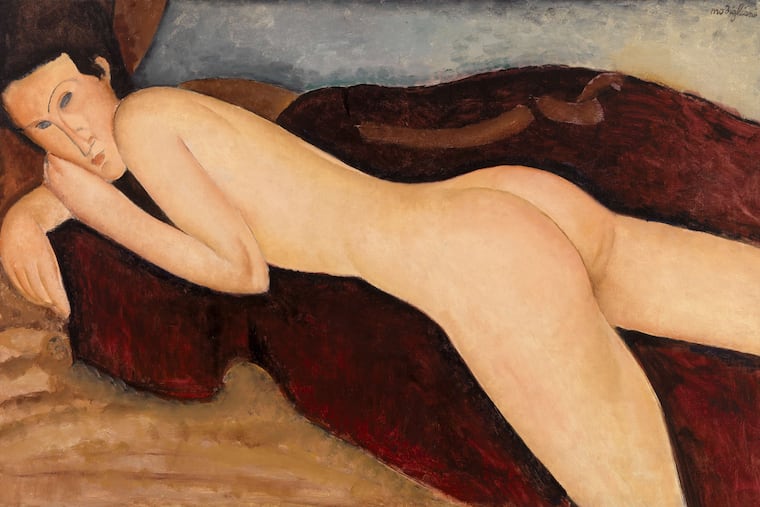You can now see the hidden art beneath Modigliani’s paintings
At the Barnes’ ‘Modigliani Up Close’ exhibit, the focus is on the artist’s unusual process.

Conservators and curators have long known there was something funky about the unusual double-sided paintings by Amedeo Modigliani.
Portrait of Maud Abrantès shows a gaunt woman with angular cheekbones who was the artist’s lover for a brief period. The funky part is that the canvas has another painting on the reverse: the 1908 portrait of a nude woman with red lips, a red eye, and a large blob of a dark hat.
Floating near Abrantès’ collarbone, barely concealed by a wash of paint, is a pair of bold blue eyes.
It wasn’t until the Hecht Museum in Haifa, owner of the double-painting since 1983, subjected the canvas to a forensic examination with X-ray technology (at the behest of the Barnes Foundation) that it became apparent just how unusual Nude with a Hat and Portrait of Maud Abrantès might be.
Beneath the surface of both paintings are multiple portraits and sketches, including a possible -portrait and a fully rendered woman with hair drawn up in a bun.
Nude and Maud — and their largely concealed ghostly underpaintings — can now be seen in “Modigliani Up Close,” which opened at the Barnes Oct. 16 and runs through Jan. 29. Presenting about 50 works from around the world, the exhibition examines the working methods and materials of the seminal Italian modernist — who left his native Livorno for Paris in 1906 and immediately struck up relationships with Picasso, Braque, Juan Gris, Soutine, and the swirl of poets and writers who made up Paris’ artistic avant-garde at the time.
Over the next 14 years, Modigliani revitalized figurative painting, created a small body of sculptures (likely using limestone pilfered from Parisian building sites), drank more than his share of absinthe, smoked a generous amount of hashish, took many lovers, and died in 1920 of tuberculosis at age 35.
The Barnes exhibition, curated by an unusual collaboration of art historians and conservators — Barbara Buckley, Barnes’ director of conservation; Simonetta Fraquelli, independent curator and consulting curator for the Barnes; Nancy Ireson, deputy director for collections and exhibitions and chief curator at the Barnes; and Annette King, paintings conservator at the Tate, London — zeroes in on what Modigliani made and how he made it.
“It was really the physical works of art that drove the choices” for the exhibition, said the Barnes’ Ireson. “While we wanted to take our visitors through the artist’s career, we wanted the materials and the processes to drive that.”
Buckley, the Barnes conservator, said the aim was “to tell the story of how he created his work through his materials and techniques.”
This focus on how Modigliani created his art led to some striking discoveries about individual works and has brought renewed attention to some iconic favorites — including works from the Barnes collection, which has one of the largest concentration of Modigliani’s works in the world, including 12 paintings, a sculpture, and drawings on paper.
» READ MORE: Six hidden gems in ‘Modigliani Up Close’ at the Barnes
What might be called the haunting of Modigliani is evident throughout the exhibit.
‘Modigliani Up Close’ runs through Jan. 29, 2023, at the Barnes Foundation. For details, visit: https://www.barnesfoundation.org/whats-on/exhibitions/modigliani-up-close